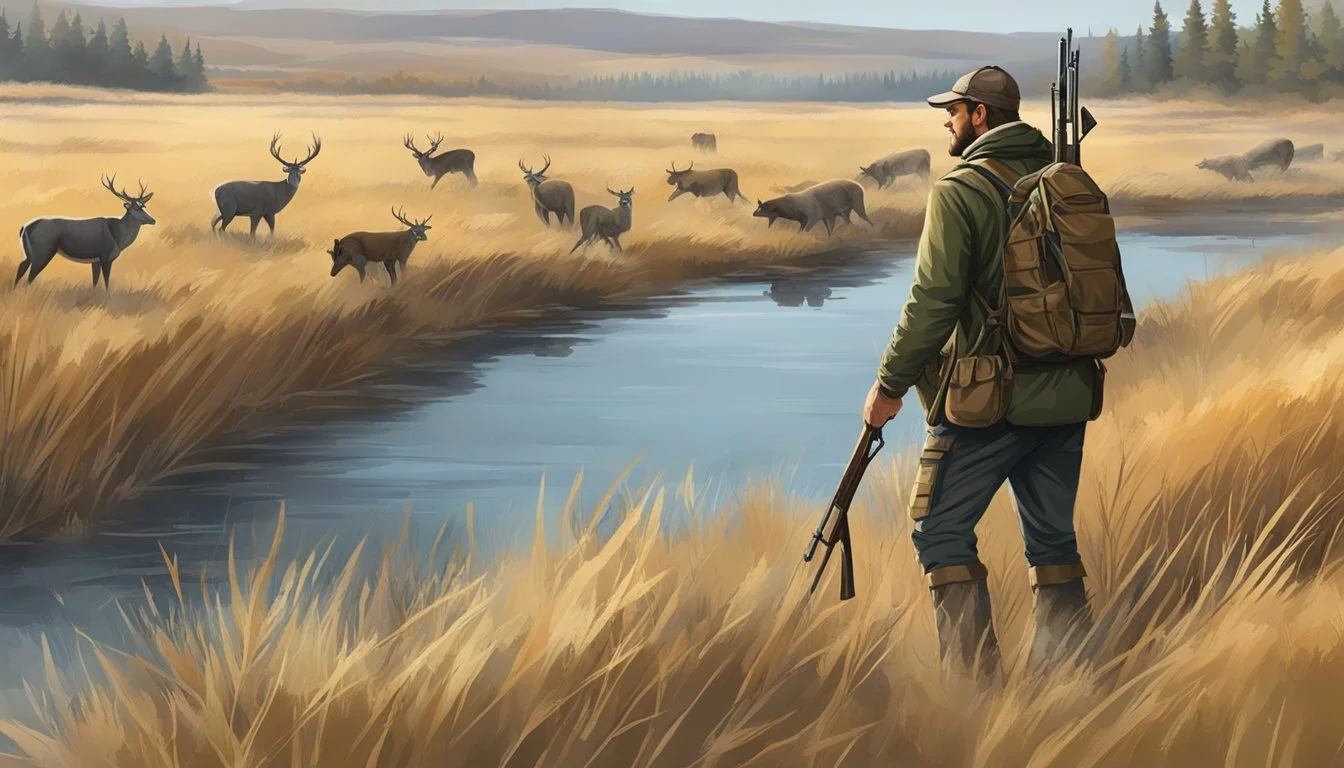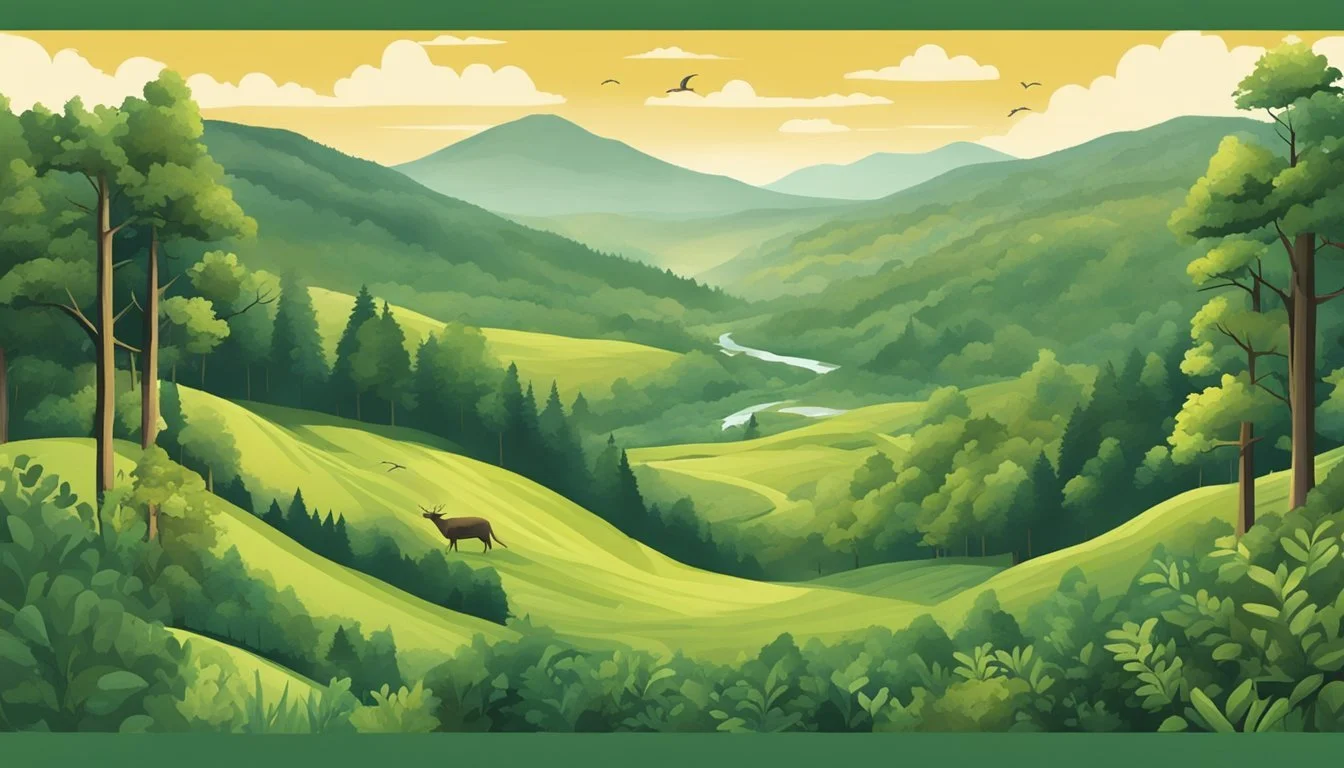Free Land for Hunters
Exclusive Access to Private Hunting Grounds
For hunters, finding prime hunting grounds without the added expense can be a game-changer. The Hunter Access Program offers a unique partnership between state game commissions and private landowners, granting hunters and trappers access to private lands to manage wildlife populations effectively. This cooperative effort not only expands hunting opportunities but also enhances wildlife habitat conservation.
Private land access programs vary by state, with some like Kansas providing extensive acreage for hunters, significantly more than what public lands can offer. These initiatives have transformed hunting experiences, making it easier for enthusiasts to find and access diverse hunting grounds without the usual competition and overcrowding found on public lands.
Outdoor enthusiasts can also utilize platforms like Landtrust, which connects hunters with private landowners. By booking access to private lands, hunters can enjoy exclusive hunting experiences tailored to their preferences. This blend of state-funded initiatives and private-sector solutions creates a broad spectrum of opportunities, ensuring hunters can discover optimal hunting terrains across the United States.
Understanding Private Lands for Hunting
Private lands offer a different experience for hunters compared to public lands, with unique benefits and considerations. These lands often require permissions and have specific roles for landowners in facilitating hunting access.
Differences Between Public and Private Hunting Lands
Public and private hunting lands present distinct opportunities and challenges. Public lands are accessible to anyone with the necessary licenses, and they include national forests, wildlife refuges, and state parks. Private lands, on the other hand, typically require explicit permission from landowners.
This can sometimes mean less competition with other hunters. Public lands are managed by various governmental agencies and often have established infrastructure such as trails and campsites, while private lands might lack these amenities but can offer greater solitude and less regulated hunting environments.
Advantages of Hunting on Private Grounds
Hunting on private grounds offers several key advantages. Private lands generally experience less hunting pressure, as access is controlled by landowners, leading to healthier wildlife populations and more predictable game patterns.
Additionally, private property can provide more personalized hunting experiences, as hunters can establish relationships with landowners to gain regular access. Sometimes, landowners may even help with game management practices, enhancing hunting success rates.
Furthermore, hunting on private land can offer safer conditions due to fewer hunters and managed access points, reducing the risk of accidents.
Overview of Types of Private Lands
Private hunting lands vary widely in type and accessibility. They can include farmlands, ranches, timberlands, and estates. Many landowners offer access through formal agreements or membership in hunting clubs.
Others participate in programs like the USDA's Voluntary Public Access and Habitat Incentive Program (VPA-HIP), which provides financial incentives to landowners who open their lands to public hunting.
In some states, large tracts of timberland are accessible to hunters for a fee. The key is to research and understand the specific type of private land available in the desired hunting area.
Roles of Landowners in Hunting Access
Landowners play a crucial role in providing and managing private hunting opportunities. They establish rules and permissions for hunters, ensuring that their land is respected and wildlife populations are sustainably managed.
Some landowners might require hunters to pay a fee or contribute to conservation efforts. Maintaining good relationships with landowners is essential for continued access.
Landowners also have the authority to implement specific game management practices, such as regulating the number of hunters, hunting seasons, and types of game targeted. These practices help create a more balanced and ethical hunting environment.
Legal Considerations
When hunting on private lands, it is crucial to understand the necessary legal requirements and responsibilities. Hunters must obtain proper licenses and permits, adhere to specific regulations and seasons, and be aware of potential liabilities and interactions with law enforcement.
Understanding Hunting Licenses and Permits
Hunters need to secure appropriate licenses and permits before hunting on any land. Each state has its own set of rules governing license requirements, which may include various types like general hunting licenses, game-specific permits, and special tags for particular species. This process ensures that hunters legally engage in their activities and supports wildlife conservation efforts. Moreover, in some regions, hunters may also be required to complete a hunter education course to qualify for a license.
Hunting Regulations and Seasons
Each state enforces specific hunting regulations to manage wildlife populations and ensure sustainable hunting practices. These regulations outline legal hunting methods, equipment restrictions, and designate specific seasons for different game. For instance, deer hunting may be allowed during a particular period in the fall, while turkey hunting could be restricted to spring. Adhering to these seasonal guidelines minimizes the impact on wildlife populations and helps balance the ecosystem. Hunters should stay updated on any changes to these regulations annually.
Liability and Law Enforcement
Hunting on private land involves certain risks, and both landowners and hunters must be conscious of liability issues. A hunting lease agreement often includes provisions to protect landowners from liability claims in case of accidents. Hunters should carry liability insurance to cover potential injuries or damages. Additionally, interactions with law enforcement are common; game wardens conduct routine checks to ensure compliance with hunting laws and regulations. It is essential for hunters to carry their licenses and permits at all times and cooperate with law enforcement to avoid legal complications.
Habitat and Wildlife Management
Effective habitat and wildlife management is essential for maintaining healthy ecosystems and ensuring sustainable hunting opportunities. This involves creating and preserving diverse habitats tailored to the specific needs of various wildlife species and enlisting hunters to assist in conservation efforts.
Species-Specific Habitats and Conservation
Managing habitats to support specific wildlife species is crucial. Biologists study the unique requirements of animals such as elk, deer, and bighorn sheep to create optimized living conditions. For example, elk require large, open meadows interspersed with forests, while mule deer thrive in areas with mixed shrubs and woodlands.
In Pennsylvania, the Hunter Access Program collaborates with landowners to improve habitats, benefiting both game and non-game species. Maintaining these environments involves actions such as controlled burns, planting native vegetation, and constructing water sources. These initiatives help conservation by supporting healthy populations and preventing habitat degradation.
Role of Hunters in Habitat Preservation
Hunters play an essential role in habitat preservation. Through programs that open private lands to public hunting, they contribute to wildlife management by controlling population sizes and preventing overgrazing. In states like Washington, public access agreements with landowners encourage responsible hunting practices while supporting habitat development.
By participating in hunting seasons and adhering to regulations, hunters help manage game populations at sustainable levels. This reduces pressure on habitats and ensures long-term viability. Their involvement in conservation efforts, such as habitat restoration projects and monitoring wildlife health, demonstrates the symbiotic relationship between hunting and environmental stewardship.
Access Programs and Partnerships
Many programs exist to provide hunters with access to private lands. These initiatives often involve government support to incentivize landowners to open their properties for public hunting.
Block Management and Other Public Access Initiatives
The Block Management Program in Montana is a prime example of a state-led initiative. It allows hunters to access millions of acres of private lands by compensating landowners. These programs often include both walk-in areas and restricted access regions where reservations might be required. Similar models exist in other states, offering flexible options for both landowners and hunters.
Other public access initiatives, like Walk-In Hunting Areas in states like Kansas, work similarly by providing financial incentives to landowners who open their lands to hunters. These programs aim to increase hunting opportunities while effectively managing wildlife resources.
Federal and State Programs to Encourage Hunting
The Voluntary Public Access and Habitat Incentive Program (VPA-HIP) is a significant federal effort to promote public hunting access on private lands. Funded through the Farm Bill, VPA-HIP provides grants to states and tribal entities.
These grants support payment programs for landowners willing to enroll their lands in public access programs. The state of Ohio, for instance, utilizes these funds to run its Ohio Landowner/Hunter Access Partnership, which compensates landowners per acre of accessible land.
States may also have their own programs apart from federal assistance. For example, North Dakota’s Private Land Open To Sportsmen (PLOTS) program focuses on providing hunter access while simultaneously promoting conservation practices.
Participation of Private Land In Public Hunting
Engaging private landowners is crucial for expanding hunting access. Programs like Ohio’s Landowner/Hunter Access Partnership offer annual payments to landowners based on land characteristics. These contracts typically last 2-3 years with the possibility of extension, ensuring ongoing access and habitat quality improvements.
Participating landowners benefit from both financial compensation and habitat enhancement initiatives. This not only supports wildlife populations but also provides hunters with more diverse and well-managed hunting grounds.
Other incentives may include tax breaks or habitat improvement assistance. It’s vital for successful partnerships that clearly communicate terms and foster mutual benefits for both landowners and hunters.
Technological Tools for Hunters
Understanding the technological tools available is crucial for any hunter looking to maximize their success on private hunting grounds. Key tools include digital mapping services, hunting apps with offline features, and satellite imagery for detailed land topography.
Digital Mapping and Land Databases
Digital mapping tools offer hunters detailed information on land boundaries and terrain. Tools like Garmin's GPSMAP 64 provide built-in worldwide base maps with shaded relief, helping hunters navigate unfamiliar areas efficiently.
onX Hunt is another popular option that offers color-coded designations for property boundaries, trails, and roads. The use of these digital maps ensures hunters stay within legal hunting areas and optimize their time in the field.
Hunting Apps and Offline Resources
Hunting apps such as HuntStand and Find A Hunt offer a range of features designed to support hunters before and during their expeditions. HuntStand provides free parcel boundaries and a robust feature set that makes it a strong choice for managing hunting areas.
Offline map access is a critical feature for hunters who venture into areas with limited or no cellular coverage. With apps like onX Hunt, users can download maps and use them offline, ensuring they never lose track of their location.
Satellite Imagery and Land Topography
Access to satellite imagery and land topography detail can significantly enhance hunting effectiveness. These tools provide a clear view of the landscape, enabling hunters to identify potential game trails, water sources, and bedding areas.
Using satellite imagery through apps like onX Hunt, hunters can better plan their routes and identify strategic spots. This information helps hunters understand the lay of the land more comprehensively, making it easier to make informed decisions while in the field.
Navigating and Scouting Strategies
Navigating and scouting private hunting lands effectively can improve a hunter's success. Key strategies include reading terrain, choosing optimal spots for tree stands and blinds, and mastering game tracking techniques.
Reading Terrain and Natural Signs
Understanding the terrain is crucial. Hunters should analyze topographical maps to identify high-probability areas such as water sources, bedding areas, and food plots. Notable terrain features include ridges, valleys, and saddles. Identifying natural signs like trails, scat, and scrapes can reveal game habits and frequented routes.
In areas with dense cover, following natural funnels and pinch points can be effective as these condense animal movement, making them ideal hunting spots. Visual cues from the environment, such as rub lines on trees, also indicate animal activity.
Strategic Placement of Tree Stands and Blinds
The placement of tree stands and blinds can determine the success of the hunt. It’s important to position stands at vantage points overlooking feeding or bedding areas while ensuring access points are non-intrusive. Choosing trees with adequate cover for concealment and safety is essential.
Using climbing aids and securing waypoints via GPS can help efficiently return to setups without disturbing the surroundings. Hunters should prioritize installing stands downwind from expected game travel routes. Blinds can be placed near water sources or game trails, blending with the environment to avoid detection.
Tips for Scouting and Game Tracking
Scouting should be a year-round activity. Utilizing tools like GPS and mapping software, such as onX Hunt, can assist in marking key locations and tracking movement patterns. Installing trail cameras at strategic points provides real-time data on game activity.
Physical scouting, such as walking the land and setting up trail cameras, provides firsthand knowledge of the terrain and animal behavior. Hunters should adapt their strategies based on the season and observed animal patterns. Maintaining minimal disturbance during scouting helps preserve natural game movement.
These strategies, when combined with consistent practice and observation, enhance hunting skills and increase chances of success.
Ethical Hunting Practices
Ethical hunting practices ensure that hunters respect private land, avoid illegal activities like poaching, and minimize their environmental impact by not littering.
Respecting Land and Landowner Rights
Hunters must always respect the rights of landowners by seeking written permission before accessing private land. Building good relationships with landowners can foster trust and lead to ongoing hunting opportunities. It's also essential to follow any specific conditions or restrictions set by the landowner. Respecting boundaries and not interfering with other property activities is crucial for maintaining a sustainable hunting environment.
Avoiding Poaching and Understanding Trespassing Laws
Poaching and trespassing are illegal and unethical actions that can lead to severe legal consequences and damage the reputation of the hunting community. Hunters must acquaint themselves with local trespassing laws and ensure they hunt only in permitted areas. Avoiding poaching requires knowing the limits and seasons for hunting specific game. Ethical hunters report any suspicious activities to authorities to help protect wildlife and maintain legal hunting practices.
Minimizing Environmental Impact and Litter
Minimizing environmental impact is a key aspect of ethical hunting. Hunters should strive to leave no trace by properly disposing of litter and avoiding the disruption of natural habitats. Using non-toxic shot and minimizing vehicle use can help reduce ecological footprints. Ethical hunters also participate in conservation efforts and practice sustainable hunting techniques to ensure healthy wildlife populations and ecosystems for future generations.
State-Specific Considerations
Different states offer distinct advantages and challenges for hunters seeking free private hunting grounds. Factors such as local regulations, available programs, and unique wildlife considerations all play a role.
Hunting in Western States (CO, WY, NM)
The Western states, including Colorado, Wyoming, and New Mexico, feature vast expanses of land with a variety of game species. In Wyoming, the Access Yes program aids in unlocking landlocked public lands by negotiating access through private properties. Colorado offers the Ranching for Wildlife program, allowing public hunting on participating private lands. New Mexico's private lands often operate under the EPLUS (Elk Private Land Use System), granting hunters elk tags in exchange for landowner cooperation. Public lands like National Wildlife Refuges also provide hunting options, but they may require specific permits.
Midwest Hunting Grounds (KS, NE, SD, IA)
The Midwest states of Kansas, Nebraska, South Dakota, and Iowa are known for rich game populations, particularly birds and deer. Kansas' Walk-In Hunting Access program opens up private lands to the public. Nebraska has a similar Open Fields and Waters program that provides access to private lands for hunting. South Dakota's Controlled Hunting Access provides a managed way to hunt on private lands. In Iowa, the Iowa Habitat and Access Program (IHAP) incentivizes landowners to open up their properties for public hunting. Each state has specific regulations and seasons that hunters must follow.
Eastern States and Their Hunting Culture (PA, MI, MN)
In the Eastern states like Pennsylvania, Michigan, and Minnesota, hunting culture is deeply ingrained. Pennsylvania’s Hunter Access Program connects hunters with private landowners willing to open their lands for hunting. Michigan features the HAP (Hunter Access Program), offering various private lands for hunting. Minnesota has the Walk-In Access program, which is similar to other states, granting access to private lands. These programs are crucial due to the smaller average property sizes compared to Western states, making secured hunting spots valuable. Local state regulations on bag limits and hunting seasons are particularly important in these densely populated regions.
Additional Resources and Further Reading
For hunters seeking free or easily accessible hunting grounds, various resources can provide valuable information.
Maps
Interactive maps like the State Land Inventory Map are essential tools. They help hunters identify public and private hunting areas, making it easier to plan trips.
Public Hunting Land
The Bureau of Land Management (BLM) and the National Park Service offer extensive public lands for hunting. Hunters can use the Government Lands Layer on mapping apps to differentiate between public and private lands, with US Forest Service lands shown in green and state lands in cyan.
State Wildlife Areas
Oregon, for instance, has several state Wildlife Areas that cater to hunters. These areas are managed intensively for both hunting and wildlife viewing. It's crucial to check whether hunting is allowed on each specific parcel of land.
Private Land Programs
Special programs like Oregon’s walk-in access initiatives open up private lands to hunters. Additionally, the Voluntary Public Access and Habitat Incentive Program under the U.S. Farm Bill aids states in creating new public hunting opportunities on private lands.
Online Platforms
Apps such as onX Hunt and HuntWise offer digital tools for scouting and managing hunting trips. These platforms provide details on land ownership and access permissions, thus simplifying the scouting process.
Division of Wildlife
Many state divisions of wildlife have dedicated resources and guides on available hunting lands. They often provide printed and online resources, including regulations, maps, and region-specific hunting information.
These are just a few resources hunters can explore to find free hunting land and enhance their hunting experiences.







